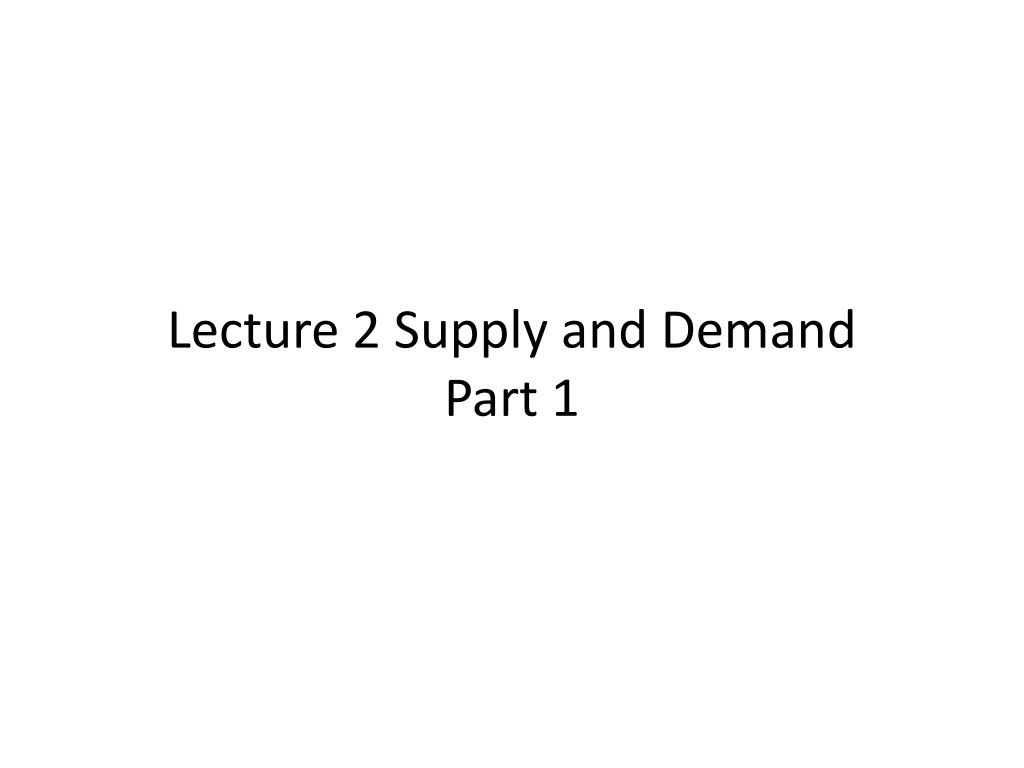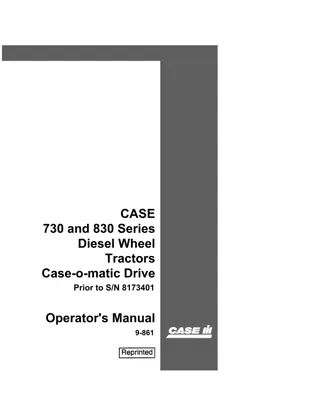
Understanding Supply and Demand in Free Markets
Explore the fundamentals of supply and demand in free markets through lectures on market equilibrium, shortages, surpluses, and factors influencing supply and demand. Delve into the workings of the market mechanism and different economic systems like free markets and centralized economies.
Download Presentation

Please find below an Image/Link to download the presentation.
The content on the website is provided AS IS for your information and personal use only. It may not be sold, licensed, or shared on other websites without obtaining consent from the author. Download presentation by click this link. If you encounter any issues during the download, it is possible that the publisher has removed the file from their server.
E N D
Presentation Transcript
Lecture 2 Supply and Demand Part 1
Road map Free markets How markets work: Supply-Demand Model Demand side Supply side Market Equilibrium Shortages Surpluses Factors that affect the demand Factors that affect the supply
Something to think about Tall, Grande, or Venti? The market mechanism will show you the way!
Road map Free markets How markets work: Supply-Demand Model Demand side Supply side Market Equilibrium Shortages Surpluses Factors that affect the demand Factors that affect the supply
Market Mechanism Buyers Sellers
Free Markets vs. Centralized Economies Free market A market with no intervention by any central authority in the allocation of resources. Centralized economy: A central committee sets production targets for all the producers. E.g., former Soviet Union. Mixed economies: In between the two extremes There is some intervention in the allocation of resources by the government Most economies today are free
Adam Smith
Ranking the World by Economic Freedom
Ranking the World by Economic Freedom
Road map Free markets How markets work: Supply-Demand Model Demand side Supply side Market Equilibrium Shortages Surpluses Factors that affect the demand Factors that affect the supply
Example of a Demand Schedule: the Market for Pizza Slices When the price drops buyers are willing to buy more pizza slices.
Demand Curve (Demand) It is a curve that shows the quantity of a good that buyers are willing to buy at each price. It is downward sloping due to the inverse relationship between the price and the quantity demanded. The reason for that is: substitution effect (when pizza is more expensive, we switch to other foods) income effect (when pizza is more expensive our purchasing power is reduced)
Road map Free markets How markets work: Supply-Demand Model Demand side Supply side Market Equilibrium Shortages Surpluses Factors that affect the demand Factors that affect the supply
Example of a Supply Schedule: the market for pizza slices When the price drops suppliers are willing to provide fewer pizza slices.
Supply Curve (Supply) It is a curve that shows the quantity of a good that suppliers are willing to provide at each price. It is upward sloping due to the positive relationship between the price and the quantity supplied. The reason for that is: suppliers are willing to sell additional slices if the price they receive is sufficient to cover the extra cost of producing them.
Road map Free markets How markets work: Supply-Demand Model Demand side Supply side Market Equilibrium Shortages Surpluses Factors that affect the demand Factors that affect the supply
Why Do Oil Prices Change? The world runs on petroleum products: Gasoline for automobiles Diesel fuel for trains and trucks Heating oil Proven reserves: 1,661 billions barrels Undiscovered reserves: 565 billion barrels Oil consumption: 101 million barrels per day Will oil reserves gone in the second half of the 21st century?
Oil Prices are Never Stable High volatility in 70s 30-year lows in 1998 Doubled in 1999-2000 Doubled in 2003-2005 Doubled in 2007-2008 Spiked in 2011
What Caused this Rapid Change in Oil Prices? Political Historical Environmental reasons. Short answer: Increased world demand Problems in oil supply chain Alternative means and resources
What Caused this Rapid Change in Oil Prices in 2002-2008? Global economic expansion Coming out of the 2001-dot-com-bubble recession Significant increase in miles driven by American families Substitution from more fuel-efficient cars to less fuel-efficient vans and SUVs Long-term expansion of demand in India and China Globalization and technological progress Supply-demand: a useful tool
Demand and Supply Schedules Price in $ Quantity demanded (slices) Quantity supplied (slices) 4 8 16 3 12 12 2 16 8
Demand and Supply Schedules Price in $ Quantity demanded (slices) Quantity supplied (slices) 4 8 16 3 12 12 2 16 8
Equilibrium: The Supply-Demand Diagram
Equilibrium It occurs when the price is $3, and the quantity is 12 slices. At this price, the suppliers can sell all they wish to sell. Also, buyers can buy exactly as many units of the good as they wish. Why does the economy end up being in equilibrium at this price and quantity?
Equilibrium How does the market reach that point? Free market assumption the price is not set by the government Somehow the market gravitates to that point
Road map Free markets How markets work: Supply-Demand Model Demand side Supply side Market Equilibrium Shortages Surpluses Factors that affect the demand Factors that affect the supply
Excess Demand At $2: quantity demanded > quantity supplied Shortage The suppliers adjust: Production increases Prices increase too due to the extra production cost Movement along the supply curve Consumers respond: Quantity demanded decreases as prices increase Movement along the demand curve The market returns to the equilibrium
Road map Free markets How markets work: Supply-Demand Model Demand side Supply side Market Equilibrium Shortages Surpluses Factors that affect the demand Factors that affect the supply
Excess Supply At $4: quantity supplied > quantity demanded Surplus The suppliers adjust: Production decreases Prices decrease too due to the drop in the production cost Movement along the supply curve Consumers respond: Quantity demanded increases as prices decrease Movement along the demand curve The market returns to the equilibrium
Puzzle solved: Tall, Grande, or Venti? Tall Grande Venti Who set the price for your favorite Starbucks coffee? Supply and Demand; The market mechanism
Source: https://checksbalances.clio.n l/2017/03/the-wounded- invisible-hand-regulating- the-world/
Factors That Affect the Equilibrium The equilibrium price that we pay for goods, services, and assets, is not fixed. If climate change affects the production of coffee beans, how will coffee prices change? The supply-demand model can help us understand the factors that affect prices.
Road map Free markets How markets work: Supply-Demand Model Demand side Supply side Market Equilibrium Shortages Surpluses Factors that affect the demand Factors that affect the supply
Factors that Affect the Demand The demand captures the effect of prices on the quantity demanded. There are other influences on demand. Graphically, these influences are captured by a shift of the whole demand curve.
Factors that Affect the Demand: Consumer Incomes The market is in equilibrium at A There is an increase in consumer income (the economy is expanding) More consumers can afford buying laptops Total demand increases (from D to D ) New equilibrium: at B More output is produced and bought (normal good), but prices increase as well.
Factors that Affect the Demand: Population Growth The market is in equilibrium at A There is an increase in the population (baby boomers) More consumers enter the market for wheat Total demand increases (from D to D ) New equilibrium: at B More output is produced and bought (normal good), but prices increase as well. Price for wheat S B A D D Quantity of wheat
Other Factors that Affect the Demand Consumer preferences Higher demand for beach products in the summer Higher demand for hot tea and hot chocolate in the winter Future expectations We borrow to buy a house when we think that we will be able to pay the mortgage in the future Favorable consumer preferences or optimistic expectations about the future will increase the demand.
Factors that Affect the Demand: Complement Goods The market for tennis balls. Initial equilibrium: price=$1 and quantity= 40 There is a decline in the tennis court fee Tennis balls and tennis court are complements in consumption The demand for tennis balls increases to D Both the equilibrium price and quantity increase Complements goods in consumption: A decrease in the price of one causes a rightward shift in the demand curve for the other.
Factors that Affect the Demand: Substitute Goods The market for overnight mail delivery Initial equilibrium: price=$P and quantity= Q There is a decline in the price of internet Overnight mail delivery and email court are substitutes in consumption The demand for mail delivery decreases to D Both the equilibrium price and quantity decrease Substitutes goods in consumption: A decrease in the price of one causes a leftward shift in the demand curve for the other.
Summary of the Factors that Shift the Demand 1.Consumer income 2.Population growth 3.Consumer preferences 4.Future expectations 5.Complement goods in consumption 6.Substitute goods in consumption
Road map Free markets How markets work: Supply-Demand Model Demand side Supply side Market Equilibrium Shortages Surpluses Factors that affect the demand Factors that affect the supply
Factors that Affect the Supply The supply captures the effect of prices on the quantity supplied. There are other influences on supply. Graphically, these influences are captured by a shift of the whole supply curve.
Factors that Affect the Supply- Example: The Size of the Industry the industry More producers enter the market for elect. cars Total supply increases (from S to S ) New equilibrium: at B More cars are produced and sold at lower prices. Market for electric cars The market is in equilibrium at A There is an increase in the size of Price electric cars S S A B D Quantity of electric cars
Other Factors that Affect the Supply Technological progress Technological progress during the pandemic more online services (education) Space shuttles and outer space transportation Future expectations Managers that are confident about the future will tend to invest more and increase their productive capacity Prices of inputs: Increase in oil prices in the 70s and 80 s global crisis and decrease in production
Summary of the Factors that Shift the Supply 1.The size of the industry 2.Prices of inputs (labor, capital, materials) 3.Technological progress 4.Future expectations
Takeaways 1. The market mechanism takes place every time there is a market where buyers and sellers trade goods, services, or assets for a price 2. Markets can be free, mixed, or centralizes ones 3. The demand describes the willingness of the buyers to buy more as the price of the good decreases (keeping all other factors constant) 4. The supply describes the willingness of the suppliers to producer more as the price of the good increases (keeping all other factors constant)
Takeaways 5. The market gravitates to the equilibrium: mutual agreement between sellers and buyers on the price and quantity. 6. The reason why the market reaches equilibrium is due to the elimination of surpluses and shortages 7. Surpluses are eliminated due to a decrease in price 8. Shortages are eliminated due to an increase in price 9. There are factors that affect the demand and the supply and result in a different equilibrium price and quantity sold in every market



